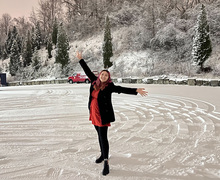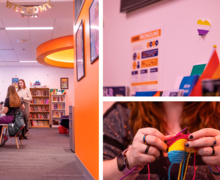An SU student startup uses virtual reality to read the news
Ally Moreo | Photo Editor
Pritesh Desai launched Little Maxima, a virtual reality newsreading app, last month
Reading the news can be a standard procedure for many people. They snag a newspaper, flip through an app or scroll through a website. But for those who own an Oculus Rift headset, they can now read the news in virtual reality.
Little Maxima is a student-created virtual reality news reading app and one of the first of its kind. Users can choose stories to read from its pinned location on a globe, allowing them to know where the story is happening. Each story is accompanied by three different articles, meant to give the reader a variety of perspectives on the same topic. The free app, which launched at the end of March on the Oculus Rift store, has already amassed more than 500 downloads.
“Instead of just reading an article, when you actually put on the headset you are taken to that place, and you’re seeing things,” said Pritesh Desai, the app’s creator and co-CEO. “And instead of seeing things that happen in a faraway corner, it’s something that actually impacts you.”
After strapping on the wired headset and grasping the two controllers, a user is welcomed with the globe. Using the knobs on the controllers, they can rotate and zoom in and out of the Earth. To read a story, a user chooses a pin and zooms all the way in, where they see the three articles, which are not attributed to their respective publications to reduce bias.

Ally Moreo | Photo Editor
Desai, a computer engineering graduate student at Syracuse University, said he created the app after frequently visiting the Alan Gerry Center for Media Innovation to play with the Oculus and the HTC Vive. The lab, filled with white tables, orange-cushioned swivel chairs and hundreds of dollars of virtual reality equipment, is where the team does most of its work. Little Maxima’s updates plan is scrawled onto glass whiteboards mounted on the walls.
Currently, a lot of virtual reality applications are games where you are “killing zombies,” Desai said, but there are more meaningful applications for the medium. He started building the app in Unity — typically used to make games — over winter break.
“I believe in VR. Like I believe it is magical,” Desai said. “It’s as close to magic as any technology can possibly take us.”
The stories on Little Maxima are chosen by an algorithm, which Desai updates every few days, said Asa Worthley, a junior marketing and entrepreneurship and emerging enterprises double major and Little Maxima’s chief marketing officer.
While the app currently has positive reviews, the initial launch wasn’t so smooth. The first review on the Oculus store said Little Maxima was “the worst VR app I have seen in a long time,” according to one user.
“It was almost like he took our baby and stabbed it,” Desai said.
But the negative review ended up helping Little Maxima. Desai posted a screenshot of the review in Reddit, and the post “exploded,” Worthley said. People were curious and wanted to try the app, and soon over 100 people were downloading and commenting.
Now the team — Desai, Worthley and Nishant Raman, a student at the University of Texas at Austin — is working on its first update. They want to improve the options for music, finesse the zooming capabilities, change the background the stories are read in and add borders and labels for the countries on the map.
Worthley also said they hope to introduce video into Little Maxima. He will be shooting 360 video at the People’s Climate March on April 29 in Washington D.C., which will hopefully be made into exclusive content for the app, he said.
“Reading the news is great, but … people just want their news quickly, so I think adding a more immersive element — a different way to experience news — will push people to the headsets,” Worthley said.

Ally Moreo | Photo Editor
Right now, Little Maxima is in the “chicken and egg” stage, where it needs to prove that virtual reality is the ideal space to watch 360 videos, said Dan Pacheco, who holds the Peter A. Horovitz Chair of Journalism Innovation and is an adviser for the startup. Travel is a big area in virtual reality, he said, and if the team could curate a lot of 360 videos, the app could grow very popular.
Desai is also working on getting into a business accelerator, which will provide money, resources and time for Little Maxima. He has heard back from a few but nothing has been confirmed yet. The app is currently free, and while the accelerators have asked how Little Maxima plans to make money in the short-term, the team hopes to keep it open to encourage people to download and try it, Worthley said.
Right now the main competition for Little Maxima are news companies that have launched their own VR apps, including CNN, and virtual reality companies that create individual experiences, like Emblematic, which recently visited SU as part of Sundance Ignite On Tour. But in the end, progress made by these companies helps Little Maxima because they make virtual reality more mainstream, Worthley said.
Pacheco said the startup highlights what the innovation lab is meant to do — bring together VR enthusiasts from across majors and schools.
“These people come through and then my job is basically just to see the dots and be like, ‘You two dots should connect,’’’ Pacheco said. “Often they just run into each other, like Asa and Pritesh, and that’s the way innovation happens.”
Published on April 17, 2017 at 9:37 pm
Contact Haley: hykim100@syr.edu





